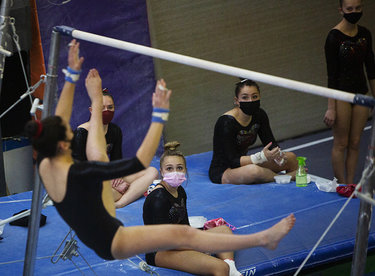Guilderland plans for a second semester similar to the first
The Enterprise — Michael Koff
Sports are an important part of school and Guilderland plans to continue next semester with sports allowed by the state, like gymnastics. Here, Ali Rem, Carli Rem, and Erika Irwin all watch teammate Addie Seebode fly between the lower and upper bar during a competition this week.
GUILDERLAND — The school district here is planning, in the midst of an ongoing pandemic, for a second semester that looks a lot like the first.
The second semester starts on Feb. 1.
Last summer, the district developed a plan that allowed Guilderland’s youngest students to attend classes in person, while still maintaining the required six-foot distance.
Students in kindergarten through sixth grade could receive daily in-person instruction. Those in kindergarten through fourth grade attend their neighborhood elementary school as always.
Fifth- and sixth-graders, however, have been housed at Farnsworth Middle School. Rather than being intermixed as middle-schoolers are, the elementary students are grouped together as they were in their neighborhood schools, just in a new location.
Eighth-graders moved over to the high school where they have their own wing.
Students in the high school have a hybrid schedule where they alternate remote learning with in-person classes.
Any student had the option of choosing to learn entirely remotely for the first semester.
“The theme has been flexibility,” said Superintendent Marie Wiles at a Jan. 13 forum.
Because of requirements for quarantining, there have been times when the district has shut down a school or part of a school for several days because of staff shortages.
“Every single circumstance has its own unique characteristics,” said Wiles.
Substitute teachers cannot just be hired “off the street,” said Regan Johnson, the district’s assistant superintendent for human resources.
Rather, they have to be approved through the Board of Cooperative Educational Services, he said.
On days when the high school has had to close, some teachers that were not quarantined have been deployed in other buildings.
Minor shifts
For the second semester, a handful of students at each of the district’s five elementary schools have chosen to return to classroom learning. Very few are moving the other way — to all-remote learning.
Eleven students each at Altamont and Guilderland elementary schools are moving to in-person learning, according to numbers the district shared at the Jan. 13 forum. Thirteen are returning to Pine Bush and 14 to Lynnwood while 33 are returning to Westmere.
Going the other way, eight Guilderland Elementary students are transitioning to remote learning along with three Westmere students.
Farnsworth Middle School has 43 students returning to classrooms while 23 are transitioning to remote learning.
The change is biggest at Guilderland High School with 90 students choosing hybrid instruction while 28 are transitioning to remote-only learning.
Altogether, 255 students are returning to riding a school bus next semester while 378 students are opting out of transportation for the second semester.
Allan Lockwood, principal of Guilderland Elementary School, described the first semester as “very successful.”
No significant changes are anticipated on the elementary level with schedules or sections.
At Westmere, two cohorts — in kindergarten and second grade — will be added and a handful of students may change sections to balance class size.
At Lynnwood, two returning kindergarten students will attend Pine Bush Elementary School for this year.
Similarly, Michael Laster, Farnsworth Middle School principal, said, “First semester has been really, really great.”
He also said, “We are welcoming some students back from Tawasentha, our remote house.” Those students will need to be placed in a different house.
Also, a small number of middle-school students may need to be moved to a new team to access special-area courses in the second semester.
High school challenges
Michael Piscitelli, the high school principal, said he couldn’t be prouder of how his staff has adapted to this year’s challenges. He said they “had to re-learn how to teach” and added, “Their skills have just grown and grown.”
He also commended students for their diligence in following protocols such as one-way walking in corridors. Even when it meant walking outside in the snow, students complied without complaint, he said.
The biggest challenge, Piscitelli said, is increasing engagement for remote learning.
Wiles said the district has heard concerns about the hybrid model at the high school and there are challenges with “synchronous instruction of both in-person and remote students,” meaning they are being taught at the same time.
“We do recognize that many of our students are struggling …,” said Wiles. “Remote learning is a challenge for some of our children.”
Changes may be made in the high school schedule to support students who need it. Students who could benefit from daily instruction — rather than alternating days with remote learning — will be identified.
Struggling students will attend classes every day in-person instead of every other day, Piscitelli said.
And more students will be scheduled to receive academic intervention services, known as AIS.
“We’re trying to match up AIS with study halls,” said Piscitelli.
High-risk sports are currently on pause, by state directive. Piscitelli mentioned seeing athletes on the school’s cross-country team running around the parking lot and said such activity is “really critical for mental health.”
Last year, the district put together a parade to safely honor seniors and held the graduation ceremony at a drive-in theater. A committee will look at what end-of-the-year festivities are appropriate for the Class of 2021.
“Game-changer”
Teachers are eligible to get COVID-19 vaccines and some Guilderland teachers have received the first of two doses, said Wiles.
She also advised patience, noting that doses are scarce so it will take time for everyone to be vaccinated. Wiles called the vaccine “a game-changer for which we need patience.”
During the second semester, the Guilderland schools will follow the same protocols as this semester. This includes social distancing, wearing face coverings and using personal protective equipment; doing daily health screenings; and cleaning and disinfecting classrooms, school buses, and other spaces every day.
Also, every day, the district will continue to report confirmed positive COVID-19 cases to the county’s health department, Wiles said, and will continue its contact tracing as well as its new initiative for random surveillance testing.
While, in the past, Guilderland High School has been designated a point of dispensing, known as a POD, that has not happened with the pandemic. If the designation were made, Wiles said, “We would gladly assist.”
The district does not yet know what to expect in terms of required exams this school year.
The New York State United Teachers, the state’s largest teachers’ union, on Monday called on the State Education Department to request a federal waiver of testing requirements in grades 3 through 8 and in high school.
Such a waiver was granted for the last school year.
“Throughout this school year there has not been a standardized mode of instruction across the state,” wrote Jolene DiBrango, NYSUT’s executive vice president, in a letter to Betty Rosa, the state’s acting commissioner of education.
“Schools have varying degrees of in person, hybrid, and remote instruction. Without standardized instructional modes there should not be a standardized test at the end of the year,” DiBrango wrote.
She went on, “On top of this, teachers are trying to address the social emotional needs of students caused by the pandemic and racial unrest caused by the death of George Floyd.”
Further, the union is calling on the state to delay until the 2023-24 school year implementing the Next Generation Learning Standards, not giving the new tests based on those standards until the spring of 2024.
In addition to academic challenges, Guilderland is also addressing students’ emotional needs.
For students dealing with social and emotional issues, Wiles said, there is a check-in form to connect students with a trusted adult at school. There is also a mental-health clinic housed at Farnsworth Middle School.
“We’re trying to serve all of our children … [in] mind and body and spirit during this very difficult school year,” said Wiles.



